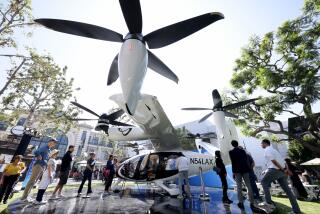New Electric Bus Enters the Fast Lane : Transit: Prototype’s use of both electric and gasoline power doubles its driving range and, designers hope, its appeal.
Calstart, a public-private consortium trying to develop an alternative-fuel vehicle industry in California, today will unveil a prototype bus powered primarily by electricity.
The bus represents the Burbank-based group’s second major project in its effort to spur mass-transit equipment manufacturing in California.
The first project, an electric car used to showcase components that could be produced by California companies, is making the rounds of international auto shows.
Calstart’s members include more than 40 aerospace firms, research institutions, major utilities and public agencies. Southern California Edison Co., a leading member of the consortium, has taken primary responsibility for the bus project.
Calstart will use the first bus to test various parts and systems, and plans to incorporate the most promising of them into a larger prototype bus to be built later.
The 22-foot model displayed in Burbank today is smaller than conventional city buses and was built by Calstart member Bus Manufacturing U.S.A., a specialty bus builder in Santa Barbara.
Under a separate contract from the U.S. Department of Energy, Bus Manufacturing is building three buses to be powered by fuel cells, an advanced system that converts various fuels to electric energy without pollution-forming combustion.
The small firm also designed the eight electric trolley buses that now carry tourists between downtown Santa Barbara and the city’s zoo and waterfront. The first Calstart bus is a modified version of those.
“This is essentially the same vehicle except that it has the transit bus skin instead of the trolley bus exterior,” said Chuck McQuary, director of transit development for the Santa Barbara Metropolitan Transit District, which will operate the bus.
Trolley buses typically have wide side entrances and bench seating, while transit buses offer front-facing seats and less room for standing.
Electric trolley buses also operate in Long Beach, Atlanta and a few other U.S. cities. Santa Barbara operates a 30-foot, full-size transit bus, recently converted from diesel power to run on batteries.
A less visible modification on the Calstart bus is the addition of a gasoline-powered engine. The engine will partially recharge the batteries and increase its range and auxiliary power--to operate air conditioning, door-opening devices and the like. Prototype electric cars have also had the problem of limited driving range, causing engineers to develop hybrid vehicles that can switch power sources from electric batteries to other fuels.
The electric trolleys have a range of 60 miles over an eight-hour day. With the addition of the gasoline engine, Calstart’s transit vehicle could travel 120 miles over 16 hours without recharging its batteries, according to Al Christ, program manager at Bus Manufacturing.
Deepak Nanda, Edison’s manager of electric transportation projects and of the Calstart bus program, says Calstart members will attempt to develop less-polluting auxiliary motors that could use natural gas and other clean-burning fuels.
Other items expected to be tested on the first prototype include improved motor control systems and a potentially more efficient main motor that would use alternating current, or AC, instead of DC, or direct current, which is used by most electric buses. More efficient motors to open doors and vents, as well as air-conditioning systems, will also be sought. Finally, Nanda hopes to test various batteries, including new sodium-sulfur batteries now made in Europe.
The most promising of these improvements will be included in the larger, 30-foot prototype--what Nanda terms “a really true transit bus”--to be built by early 1994.
More to Read
Sign up for Essential California
The most important California stories and recommendations in your inbox every morning.
You may occasionally receive promotional content from the Los Angeles Times.









